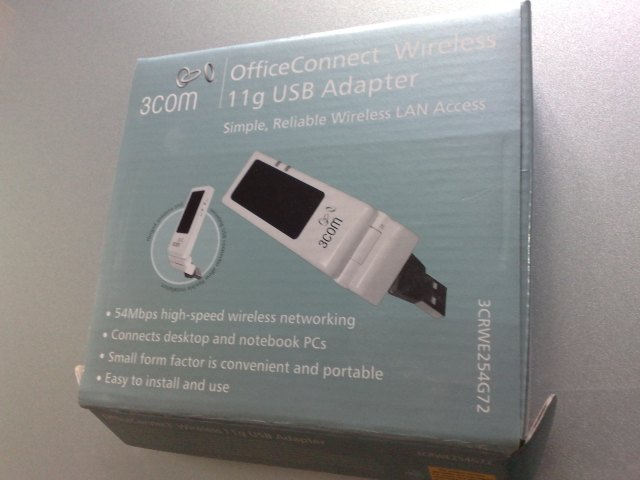Using the 3COM 3CRWE254G72 OfficeConnect Prism54USB (p54usb) USB WLAN with Debian GNU/Linux (on the Sheevaplug in particular)

Although the Sheevaplug comes with a 1gbps wired ethernet port, having a wireless networking option greatly increases the utility of the plug computer, since the only required wiring left is power.
I had an old 3COM OfficeConnect 3CRWE254G72 802.11g wifi USB dongle laying around doing nothing, which turned out to be perfect for hacking on the sheevaplug. This device has been discontinued by 3COM, but it's based on the Intersil ISL3886 chipset and is well supported by the p54 driver in Linux (previously known as prism54.org).
The device identifies in lsusb like this: 001 Device 003: ID 0506:0a11 3Com Corp. 3CRWE254G72 802.11g Adapter
Installing the required firmware for the p54usb module
The p54usb driver needs additional firmware to make the device useful. There are several versions of these floating around. If you just want it working, grab the 2.13.1.0.lm86.arm SoftMAC 05.05 firmware (md5sum: 6495bbb447bce149427182b25135820b) and install it as /lib/firmware/isl3886usb. (Assumes kernel 2.6.29+).
After putting the firmware in place, unplug & replug the usb dongle, or reload the p54usb module (rmmod p54usb; modprobe p54usb). In dmesg you should see something like this:
usb 1-1.1: firmware: requesting isl3886usb
phy0: p54 detected a LM86 firmware
p54: rx_mtu reduced from 3240 to 2392
phy0: FW rev 2.13.1.0 - Softmac protocol 5.5
phy0: cryptographic accelerator WEP:YES, TKIP:YES, CCMP:YES
phy0: hwaddr 00:00:de:ad:be:ef, MAC:isl3880 RF:Frisbee
phy0: Selected rate control algorithm 'minstrel'
Registered led device: p54-phy0::assoc
Registered led device: p54-phy0::tx
Registered led device: p54-phy0::rx
Registered led device: p54-phy0::radio
usb 1-1.1: is registered as 'phy0'
usbcore: registered new interface driver p54usb
More information about FullMAC vs SoftMAC vs FreeMAC is available in the old prism54.org faq.
Adding the wireless tools
Install the standard wireless utilities: apt-get install wireless-tools wpasupplicant Check that the wlan0 device is detected: iwconfig
Configuring the WLAN SSID, WPA key and wpasupplicant etc without NetworkManager
Based on the Debian WiFi guide:
Since you most likely won't be running an X11 GUI desktop, it is easier to avoid NetworkManager altogether, and simply configure everything in the standard /etc/network/interfaces configuration file. This file is world-readable by default, but since you'll be storing your WPA secret keys here, it may be beneficial to lock down its contents: chmod go-rwx /etc/network/interfaces
Add the following to /etc/network/interfaces:
allow-hotplug wlan0
iface wlan0 inet dhcp
wpa-ssid YOUR_SSID
wpa-psk YOUR_WPA_KEY
wpa-ap-scan 1
wpa-scan-ssid 1
And bring up the interface with:
ifup wlan0